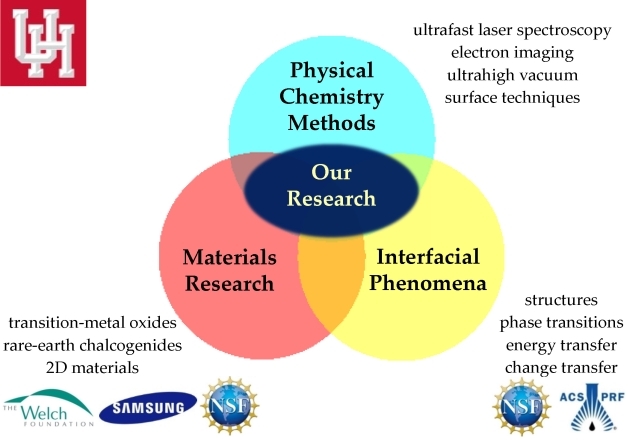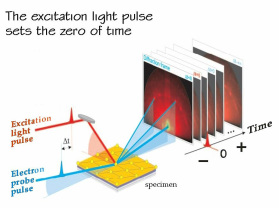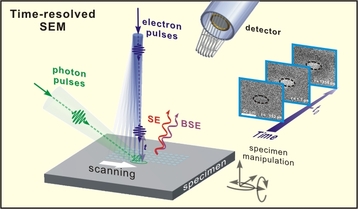Research Areas
- Energy-related (2D, photovoltaic, ultrahigh thermal conductivity, correlated) materials
- Intermolecular and interfacial interactions at solid–molecule interfaces
- Structures and phase transitions of interfacial assemblies
(self-assembled, Langmuir-Blogett, molecular, ionic liquids) - Ultrafast energy transport and charge transfer
- Nonequilibrium ultrafast phase transitions
Experimental Techniques
- Ultrafast Electron Diffraction (UED)
Femtosecond pump-probe experiments have been performed in the last three decades to study ultrafast dynamics in various chemical, physical, and biochemical systems. The techniques are mostly all-optical, which means that the dynamics initiation and probing are both made by femtosecond laser pulses. Fruitful results about conformational changes in molecules and electronic dynamics in solid materials has been acquired.
However, optical techniques are generally limited in the spatial resolution due to the intrinsic diffraction limit of light. In addition, the signals collected typically do not provide the direct information of structural dynamics.
In this regard, much effort has been invested in recent years to develop time-resolved diffraction and imaging techniques, to achieve a direct vision for sub-atomic transient structural changes with an ultrafast temporal resolution. Here, ultrafast dynamics is still initiated by a femtosecond laser pulse. However, for probing, photons with a wavelength in the x-ray range and high-energy electrons are the two main types of particles used. The latter type has a much larger (~105 times) scattering cross section by atoms, compared to photons, and is easier to generate (via the photoelectric effect) and manipulate (by electric and magnetic fields). Therefore, a photoelectron source with a moderate brightness will have enough sensitivity to time-dependent changes and to surface studies. It is also beneficial to construct a table-top apparatus that allows systematic research, especially for complex materials.
We use ultrafast electron diffraction in both reflection and transmission geometries to investigate photoinduced structural dynamics in condensed matter and at interfaces. Correlated with the knowledge of electronic dynamics obtained by using all-optical techniques, a full understanding about transient changes in materials and interfacial assemblies across a wide range of time scales may be reached. The direct structural resolution from diffraction has been proved essential in deciphering the fundamental steps during the laser-induced phase transition of vanadium dioxide and in resolving a nonequilibrium phase transition in interfacial hydrogen-bonded water networks. We expect similar applications for other energy-related correlated solids and novel materials as well as various solid–molecule interfacial systems.
- Scanning Ultrafast Electron Microscopy (S-UEM)
Scanning electron microscopy (SEM) is known for its ability to obtain 3-dimensional-like images for materials surfaces. The typical signals detected are secondary electrons (caused by the inelastic scattering of impinging electrons) and back-scattered electrons (from the original beam). The former type naturally exhibits surface sensitivity. Therefore, utilizing the laser-pump electron-probe scheme, time-resolved SEM (so-called scanning ultrafast electron microscopy) may help us to directly image surface dynamics and serve as a useful technique for nonrepetitive systems that are not suitable for diffraction.
In addition, environmental SEM has been developed for imaging materials in an ambient gas such as water vapor. This advancement helps to maintain some materials in their native states during investigation, and eliminates the conventional high vacuum or ultrahigh vacuum condition for imaging.
Taking advantage of the inherited spatial resolution, we use time-resolved scanning electron microscopy to study laser-induced electronic and structural dynamics at the surfaces of materials, devices, and nanostructures. We also exploit the environmental imaging to examine the solid–gas interaction on an ultrashort time scale, whose study has not been readily available with a simultaneous spatiotemporal resolution by other techniques.


